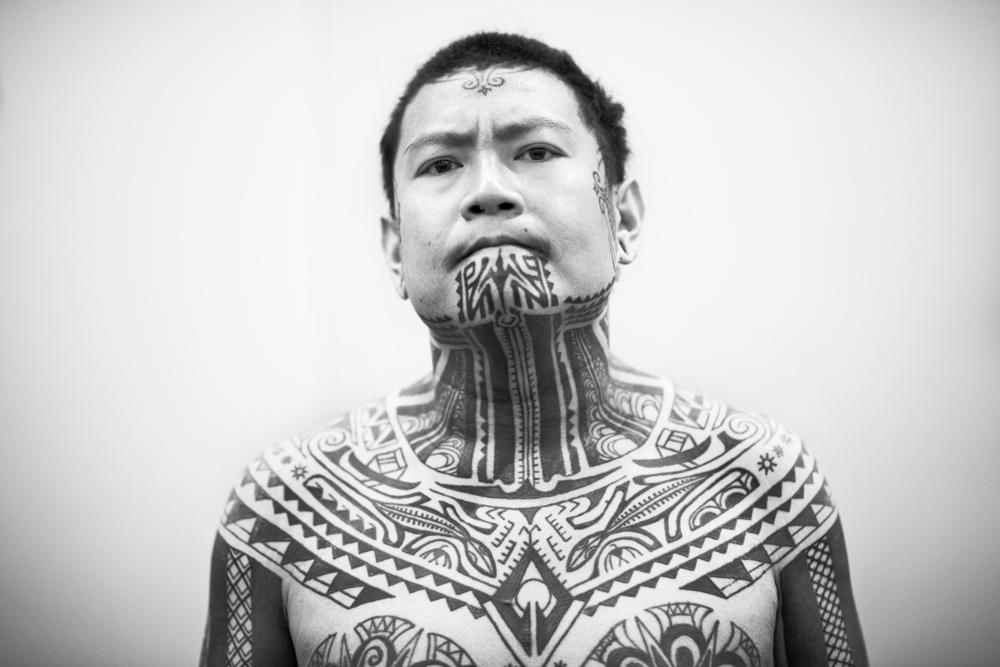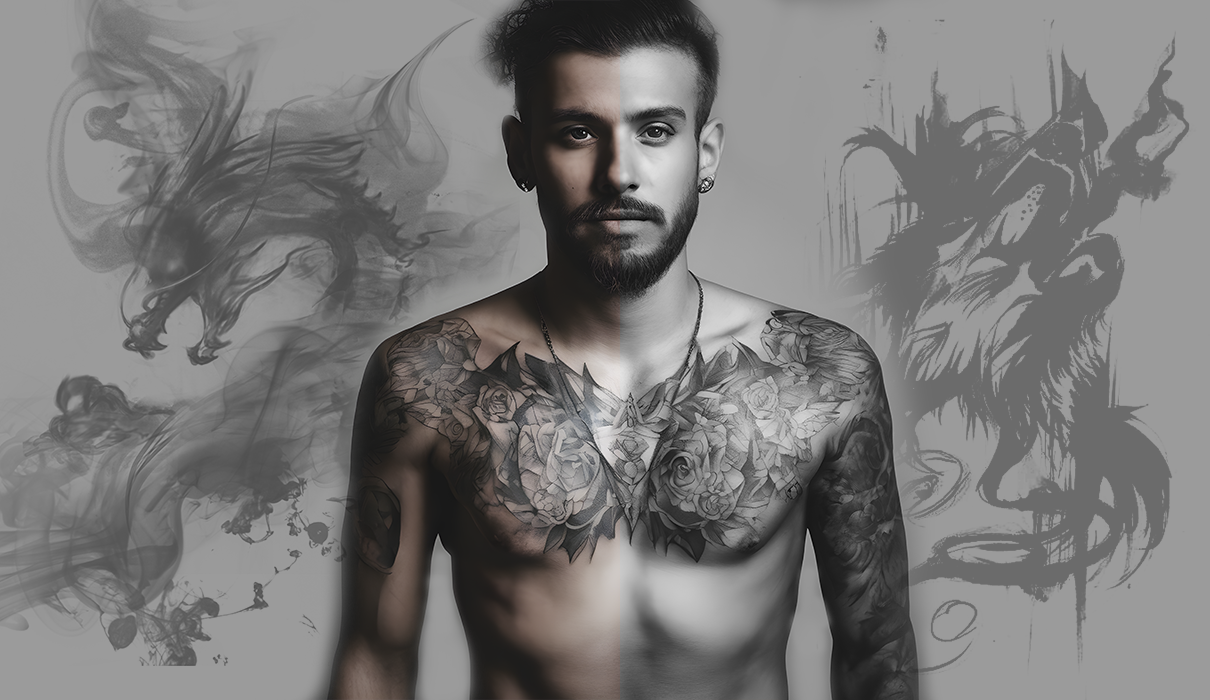Tattoos have come a long way from their traditional tribal and cultural roots. Today, they are a form of self-expression, a work of art, and a means of identifying ourselves to the world. A tattoo can be a symbol of triumph over adversity, an ode to a loved one, or a representation of our beliefs and values.
Through ink, we can convey our personal stories and shape our identities. Tattoos have the power to communicate who we are and where we come from, serving as a visual narrative of our lives. In this article, we’ll explore the various ways in which tattoos impact our lives, from their cultural significance to their role in subcultures, and even the way they impact the workplace.
Key Takeaways:
- Tattoos are a unique form of self-expression.
- They tell personal stories and shape our identities.
- Tattoos can be symbols of triumph and ode to loved ones.
- They have cultural significance and represent heritage and tradition.
- Tattoos are also used to create a sense of belonging within subcultures and communities.
The Evolution of Tattoos: From Ancient Practices to Modern Trends
Tattoos have a rich history spanning centuries and civilizations. The earliest evidence of tattooing dates back to the Bronze Age, with tattoos found on mummies from ancient Egypt and the remains of the Iceman from the Italian Alps.
Throughout history, tattoos have been used for a variety of purposes, including religious and spiritual practices, cultural identification, and social status. In Polynesia, tattoos were seen as symbols of rank and achievement, while in Japan, they were used to mark criminals and outcasts.
The popularity of tattoos in Western societies waxed and waned over the years. They were initially brought to Europe by Captain Cook in the 18th century, but they fell out of favor in the Victorian era. It wasn’t until the 1960s that tattoos experienced a resurgence, with the rise of counterculture movements like the hippies and the punks.
The Symbolism of Tattoos
The symbolism of tattoos has also evolved over time. In ancient cultures, tattoos often had spiritual or supernatural significance. In contemporary societies, tattoos are more likely to be associated with personal beliefs and individual expression. Certain motifs, such as anchors or the infinity symbol, have become popular as universal symbols of strength and perseverance.
| Symbol | Meaning |
|---|---|
| Lotus flower | Rebirth, enlightenment, purity |
| Butterfly | Transformation, beauty, freedom |
| Dragon | Power, wisdom, strength |
| Owl | Wisdom, mystery, intelligence |
| Phoenix | Renewal, immortality, rebirth |
| Wolf | Loyalty, courage, family |
| Anchor | Stability, hope, safety |
| Tree | Growth, connection, life |
| Skull | Mortality, danger, the passing of time |
| Eye | Perception, protection, enlightenment |
“Tattoos are like stories – they’re symbolic of the important moments in your life.” – Pamela Anderson
Whether it’s a small, discreet tattoo that only holds meaning to the wearer or a larger, more prominent piece that serves as a statement of identity, tattoos have become a widespread form of self-expression across cultures and social classes.
The Psychology Behind Tattoos: Unraveling the Motivations
Tattoos have become ubiquitous in modern society, with more and more individuals choosing to adorn their bodies with permanent ink. The motivations behind getting tattoos are multifaceted and complex, often rooted in personal experiences and emotions.
For some, tattoos serve as a form of self-expression, allowing individuals to display their unique personalities and beliefs. Others use tattoos as a means of asserting control over their bodies, particularly in the aftermath of trauma or loss. Some individuals get tattoos to commemorate significant life events, such as births, deaths, or marriages.
The reasons people choose to get tattoos are as varied as the individuals themselves. However, research has identified several common motivations that drive people to get inked. These include a desire for self-expression, a need to feel unique or different, a way to mark a significant personal event or milestone, and a means of coping with emotional distress or trauma.
Studies also suggest that tattoos can serve as a form of identity construction and transformation. By altering their physical appearance through tattoos, individuals may be able to redefine themselves and their relationships with others. Tattoos can also serve to align oneself with a particular social group or subculture.
Despite tattoos’ growing popularity, some stigma is associated with getting inked. Some people may view tattoos as unprofessional or inappropriate, particularly in certain job settings. However, attitudes towards visible tattoos in the workplace are changing, with many companies adopting more inclusive policies.
Overall, the psychology of tattoos is complex and multifaceted, reflecting the diverse motivations and experiences that drive people to get inked. Whether for self-expression, identity construction, or emotional healing, tattoos hold a unique and powerful place in our cultural landscape.
Tattoos as Identity Markers: Personal Expression and Individuality
Tattoos are often considered as a way of self-expression, but they also serve as identity markers. Individuals can communicate their personality, beliefs, or affiliations with a particular group or community by choosing a particular design or symbol. Tattoos allow us to express ourselves and our individuality in a very personal and permanent way.
For many, the process of getting a tattoo is a transformative experience where they take ownership of their bodies and create something unique to them. Tattoos serve as a personal expression that allows individuals to showcase their individuality and creativity. The design and placement of a tattoo reflect the wearer’s personality and preferences, giving others a glimpse into their identity.
Tattoos and Belonging
In addition to personal expression, tattoos are also used as a means of belonging and creating a sense of community. People often get tattooed with a certain design or symbol to show their affiliation with a specific group or community. This could be anything from a sports team to a religious group, or a political movement to a social cause. Through tattoos, individuals can connect with others who share similar values and beliefs, creating a sense of belonging and camaraderie.
Tattoos and Empowerment
For some individuals, tattoos serve as a form of empowerment and a way of reclaiming their bodies. This is especially true for those who have experienced trauma or significant life events. Tattoos can serve as a way to take back control, to transform a painful experience into something beautiful and empowering. In this way, tattoos can help individuals find strength and move forward in their lives.
Overall, tattoos are much more than just a form of self-expression. They serve as identity markers, tools for creating a sense of belonging, and even as forms of empowerment. If you’re thinking about getting a tattoo or already have one, consider what it means to you and how it reflects your personal identity.
Cultural Significance: Tattoos as Reflections of Heritage and Tradition
Tattoos are not just a modern trend; they have been a part of cultural practices for centuries. The significance of tattoos varies across cultures and communities, but they often reflect heritage and tradition. Tattoos have been used throughout history to signify group membership, social status, and even religious beliefs.
For example, in Japan, tattoos have traditionally been associated with organized crime syndicates, but they have also been used to represent spiritual and cultural beliefs. In Samoa, traditional tattooing, known as pe’a, has been used to signify courage, strength, and social status. Native American tribes have used tattoos to signify achievement and to record important events or stories.
Tattoos continue to play an important role in cultural expression today. They are often used to pay homage to cultural traditions and beliefs, or to connect with one’s cultural identity. Many people choose to get tattoos that reflect their cultural heritage and serve as a reminder of their roots.

The Role of Tattoos in Subcultures: Uniting Communities and Creating Bonds
Tattoos have played a significant role in uniting individuals within subcultures, creating a sense of community and shared identity. Subcultures, such as bikers, punks, and sailors, have long used tattoos as a way to express their beliefs and to distinguish themselves from mainstream society.

Tattoos within subcultures often have specific meanings or symbols that hold significance within the community. For example, among bikers, tattoos of the club’s insignia or other symbols may signify loyalty and commitment to the group. Similarly, within the punk community, tattoos may represent anti-establishment beliefs and a rejection of mainstream culture.
Through their shared tattoos, members of subcultures can bond over a common identity and sense of belonging. Tattoos allow individuals within subcultures to express themselves in a unique and meaningful way, while also creating a visual representation of their subculture’s values and beliefs.
The Role of Tattoos in Subcultures: Creating a Sense of Belonging
One of the most significant roles of tattoos within subcultures is their ability to create a sense of belonging. By getting a tattoo that represents their subculture, individuals are able to identify as a member of that community and bond with others who share similar beliefs and values.
For many individuals within subcultures, tattoos serve as a marker of their personal identity within the group. As such, tattoos can be a source of pride and a way to express themselves in a way that feels authentic and true to their beliefs.
Furthermore, tattoos within subcultures can also serve as a way to recognize other community members. By displaying a tattoo that signifies membership within a particular subculture, individuals can easily identify and connect with others who share their interests and values.
The Role of Tattoos in Subcultures: Uniting Communities and Creating Bonds
Tattoos have long been associated with various subcultures, from rebellious bikers and rugged sailors to the punk rockers and metalheads. These subcultures use tattoos as a way to create a sense of belonging and solidarity within their communities. Tattoos become a badge of honor, signifying shared beliefs and experiences.
For bikers, tattoos often feature skulls, eagles, and motorcycles, symbolizing freedom and the open road. Sailors may opt for nautical designs such as anchors, compasses, and mermaids, reflecting their life on the seas. Meanwhile, punks and metalheads may choose darker, more macabre imagery, such as skulls, demons, and zombies, channeling their love of horror and heavy music.
Regardless of the subculture, tattoos serve as a way to express one’s identity and values. They allow individuals to connect with others who share their interests and experiences. Tattoos also serve as a visible reminder of the community’s history and traditions.
The Power of Tattoos in Subcultural Communities
In many subcultures, tattoos hold a special significance. They represent a form of rebellion against mainstream culture and rejecting societal norms. Tattoos also help to create a strong sense of kinship and loyalty. Members of a subculture with similar tattoos may instantly recognize one another and feel a sense of camaraderie.
Tattoos can also serve as a way to honor fallen comrades or celebrate significant milestones. Bikers, for instance, may get tattoos in memory of friends lost on the road or to commemorate a long journey. Sailors may get tattoos to mark their first crossing of the equator or to show allegiance to a particular ship or unit.
Overall, tattoos play an important role in the subcultural landscape. They help to form bonds between individuals who may be seen as outcasts or outsiders. Tattoos provide a visual representation of shared experiences and values, allowing subcultures to thrive and grow.
The Artistry of Tattoos: Choosing the Right Design and Artist
Getting a tattoo is a personal decision and a permanent one at that. It’s important to choose the right design and artist to ensure that you end up with a tattoo you love for the rest of your life.
Consider the style of tattoo you want and find artists who specialize in it. Look at their portfolios and reviews online to get an idea of the quality of their work. Don’t be afraid to ask for recommendations from friends who have tattoos.
Hygiene is also crucial when choosing a tattoo artist. Make sure the studio follows proper sanitation practices and uses new needles for each client to minimize the risk of infection.
And lastly, remember that good tattoos aren’t cheap and cheap tattoos aren’t good. Don’t skimp on the cost of a tattoo and be willing to wait for an artist who is in high demand. It’s better to wait and get a great tattoo than to rush the process and end up with a subpar result.
Tattoos and the Workplace: Navigating the Professional Sphere
Tattoos have become increasingly common in recent years, and their presence in the workplace has sparked debates about professionalism and personal expression. While some companies have strict policies against visible tattoos, others have embraced their employees’ body art. So, how can you navigate the professional world with a visible tattoo?
Firstly, research the company’s policy on tattoos. Many companies have dress codes that explicitly state whether visible tattoos are allowed or not. If the policy is unclear, ask human resources or a supervisor for clarification. It’s better to know the company’s stance beforehand than to risk facing consequences later on.
If the company does not allow visible tattoos, there are ways to cover them up. Clothing such as long-sleeved shirts or pants can do the trick, or special makeup designed to conceal tattoos can be applied. However, keep in mind that choosing to cover up your tattoo may not always be comfortable or practical, especially in hot or humid workplaces.
It’s also important to consider the placement of your tattoo. A tattoo on the face or neck may be harder to conceal, and may therefore impact your job prospects in certain industries. On the other hand, a tattoo on the arm or wrist may be easier to cover up, giving you more flexibility in your career choices.
Ultimately, it’s up to you to decide whether to get a visible tattoo and how to navigate the workplace with it. While tattoos can be a form of personal expression, it’s important to remember that the professional world may view them differently. However, as attitudes towards tattoos continue to evolve, it’s possible that more companies will become accepting of visible body art.

Tattoo Removal: Exploring Options and Considerations
Tattoos are a lifelong commitment, but sometimes circumstances change and individuals may decide to remove them. Whether it’s due to a change in personal values or a change in employment opportunities, tattoo removal is becoming increasingly common. However, it’s important to carefully consider the options and potential risks before deciding on removal.
There are several methods of tattoo removal available, including laser removal, surgical excision, and dermabrasion. Laser removal is the most common and effective method, using high-intensity light to break up the ink particles in the skin. Surgical excision involves cutting out the tattooed skin, while dermabrasion uses a rotating brush to remove the layers of skin containing tattoo ink.
It’s important to note that while these methods may be effective, they also carry risks such as scarring, infection, and changes in skin pigmentation. In addition, the process can be painful and may require multiple sessions depending on the size and complexity of the tattoo.
Before deciding on tattoo removal, it’s important to consider the potential emotional impact as well. Tattoos often hold personal significance and removing them can be a difficult decision. It’s important to seek support from friends, family, or a mental health professional if needed.
Overall, tattoo removal should be carefully considered and researched before proceeding. It’s important to consult with a qualified professional and carefully weigh the risks and benefits before making a decision.
Future Trends: The Evolving World of Tattoos
The world of tattoos is constantly evolving, with new advancements and trends always emerging. As technology continues to advance, it’s likely that we’ll see more innovative techniques and designs in the coming years.
Tattoo Psychology
One emerging trend is the use of tattoo psychology, which involves incorporating psychological concepts and theories into tattoo designs. This can include symbols and imagery that represent personal growth, self-discovery, and mental health.
3D Tattoos
Another trend that’s gaining popularity is 3D tattoos, which use shading and perspective to create a three-dimensional effect. This technique can create incredibly realistic and visually striking designs.
Watercolor Tattoos
Watercolor tattoos are also becoming more popular, with artists using a variety of techniques to create designs that resemble watercolor paintings. These tattoos often incorporate vibrant colors and abstract designs.
Minimalist Tattoos
On the other end of the spectrum, minimalist tattoos are also gaining popularity. These tattoos use simple, clean lines and designs to create a subtle yet powerful statement.
Virtual Reality
As VR technology becomes more widespread, some tattoo artists are exploring the potential for using virtual reality to create and preview tattoo designs. This could revolutionize the tattoo industry and provide a new level of customization for clients.
With so many new trends and techniques emerging, the world of tattoos is as exciting and dynamic as ever. Whether it’s incorporating psychological concepts, creating stunning 3D designs, or exploring minimalist styles, there’s no shortage of options for those looking to get inked.
Conclusion
Tattoos have been an integral part of human culture for centuries. From ancient practices to modern trends, tattoos have evolved both in their style and symbolism. In today’s society, tattoos serve as a form of self-expression, allowing individuals to tell personal stories and shape their identities.
The psychology behind tattoos is complex, with motivations ranging from cultural significance to personal empowerment. Tattoos serve as powerful identity markers, allowing individuals to express their unique personalities and beliefs. In subcultures, tattoos are used to create a sense of belonging and community.
As tattoos become more visible in society, attitudes towards them are changing. While there are still challenges to navigate in the workplace, tattoos are increasingly being accepted as a form of personal expression.
For those considering getting a tattoo, it’s important to choose the right design and artist. It’s also important to carefully consider the decision to get a tattoo and the potential implications, including the options for removal.
As the tattoo industry continues to evolve, we can expect to see new trends and technologies emerge. However, one thing remains constant: the artistry of tattoos and their ability to tell our stories and shape who we are.
FAQ
Q: How do tattoos tell stories and shape who we are?
Tattoos have the power to tell personal stories and shape our identities by serving as a form of art and self-expression. They can represent significant life events, beliefs, and values, allowing individuals to showcase their unique personalities and experiences.
Q: What is the history of tattoos?
Tattoos have a rich history, originating in ancient cultures where they were used for various purposes such as social status, spiritual protection, and cultural traditions. Over time, tattoos have gained popularity in contemporary society and evolved in terms of symbolism and artistic techniques.
Q: What motivates people to get tattoos?
The motivations for getting tattoos vary from person to person. Some individuals may choose to get tattoos as a form of self-expression, to commemorate a significant life event, or to honor their heritage. Others may use tattoos as a way to reclaim their bodies and find healing and empowerment.
Q: How do tattoos contribute to personal expression and individuality?
Tattoos serve as identity markers that allow individuals to express their unique personalities and beliefs. They provide a visual representation of who we are and what we value, contributing to the formation of our individual identities and allowing us to stand out from the crowd.
Q: What is the cultural significance of tattoos?
Tattoos hold cultural significance as reflections of heritage, traditions, and cultural practices. They can symbolize important aspects of a person’s cultural identity and be used to preserve and celebrate cultural heritage.
Q: How do tattoos unite communities within subcultures?
Within subcultures such as bikers, punks, and sailors, tattoos play a significant role in creating a sense of belonging and solidarity. They serve as visual markers of shared values, interests, and experiences, helping to foster strong bonds within these communities.
Q: How can tattoos serve as a form of healing and empowerment?
Tattoos can be transformative for individuals who have experienced trauma or significant life events. They can help individuals reclaim their bodies, find healing, and empower themselves by symbolizing strength, resilience, and personal growth.
Q: How do I choose the right design and artist for my tattoo?
When selecting a tattoo design and artist, it is important to consider factors such as style, skill, and hygiene. Take the time to research different artists, view their portfolios, and ensure they have a clean and professional studio environment.
Q: How do tattoos affect employment and the professional sphere?
Attitudes towards visible tattoos in the workplace have been changing, but it is important to navigate potential challenges carefully. Consider the industry you work in and the company culture before deciding on visible tattoos, and be prepared to cover them if necessary.
Q: What are the options and considerations for tattoo removal?
Tattoo removal options include laser removal, surgical removal, and tattoo cover-ups. Before deciding on removal, it is important to consider factors such as the size, color, and age of the tattoo, as well as the potential cost and recovery time.
Q: What are the future trends in the world of tattoos?
The tattoo industry is constantly evolving, with technological advancements and changing social perceptions. Future trends may include innovations in tattoo ink, new tattoo techniques, and a continued exploration of the psychological aspects of tattoos.


